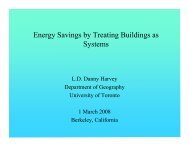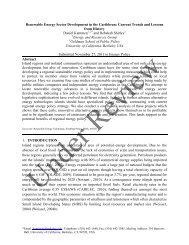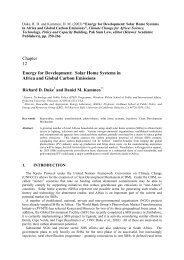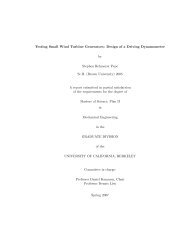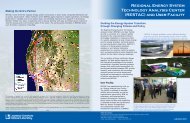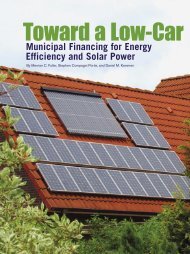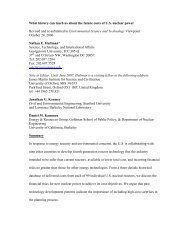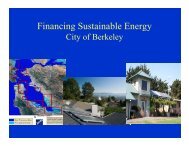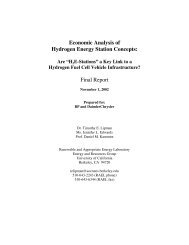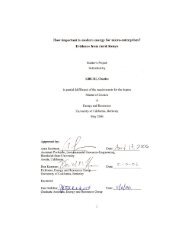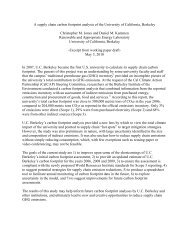Informing the Financing of Universal Energy Access: An Assessment ...
Informing the Financing of Universal Energy Access: An Assessment ...
Informing the Financing of Universal Energy Access: An Assessment ...
You also want an ePaper? Increase the reach of your titles
YUMPU automatically turns print PDFs into web optimized ePapers that Google loves.
ELECTR-5744; No <strong>of</strong> Pages 26Figure 5: Lorenz Curves for Residential Electricity in Five Countriesincreased investment in energywill benefit <strong>the</strong> poor moststrongly in cases where electricityconsumption is relativelyequitable. Unfortunately, thosecountries with <strong>the</strong> worst energyaccess problems are usuallyamong those with <strong>the</strong> mostinequitable access to energy (cfKenya in Figure 5).The Gini coefficients forresidential electricityconsumption presented in <strong>the</strong>legend <strong>of</strong> <strong>the</strong> graph (inparen<strong>the</strong>sis) provide a singlequantitative measure <strong>of</strong> <strong>the</strong>distribution <strong>of</strong> consumptionacross <strong>the</strong> population for <strong>the</strong>respective countries (Jacobsonet al., 2005).A n important aspect <strong>of</strong> anyenergy access program isthus to examine, address, andplan for <strong>the</strong> differences in not onlytotal funding needed, but also inapproaches for populations thathave and do not readily haveaccess to on-grid energy. In <strong>the</strong>case <strong>of</strong> Kenya, for example, gridextension, mini-grids, and <strong>of</strong>fgridlighting options are allimportant technologies toexamine, which in turn changes<strong>the</strong> funding needs to providemodern energy services. Fur<strong>the</strong>rwork in this area is nowunderway.B. <strong>Energy</strong> poverty vs.investment in energyThere does not appear to be adistinguishable relationshipbetween investment in energyinfrastructure and degree <strong>of</strong>energy poverty (Figure 6). WhileGFCF appears to be positivelycorrelated with <strong>the</strong> total number<strong>of</strong> people without access toelectricity, that correlationdisappears once one controls fortotal population. (For Figures 6and 7, we selected <strong>the</strong> LDCcountries for which we had <strong>the</strong>most confidence in <strong>the</strong> nationaldata sets.)S till, it is clear that existingcountry-specific investmentflows in <strong>the</strong> energy sector aregenerally not sufficient to meet<strong>the</strong> needs <strong>of</strong> providing electricityservices to those 1.4 billionpeople who currently lackany access – even if all investmentwas directed toward expandingaccess. In practice, <strong>of</strong> course,much <strong>of</strong> any investmentwill be directed towardincreasing supplies (and quality)to those who already have someaccess.Bazilian et al. (2010a,b) estimatethat <strong>the</strong> total cost <strong>of</strong> universalaccess to electricity for householduses and modern energy servicesfor cooking could exceed USD 70billion per year on average to2030. 33 Focusing on countrieswith very low electrificationrate, we compare (Figure 7)energy-related GFCF in2008 with <strong>the</strong> estimatedannual average cost <strong>of</strong> universalhousehold electrification in leastdeveloped countries LDCs by2030. 34Figure 7 indicates that evenif all investment in energycapital was redirected toexpanding access, it would beinsufficient to bring about fullhousehold electrification by 2030for most LDCs analyzed. Forseveral countries (e.g.,Democratic Republic <strong>of</strong> <strong>the</strong>Congo, Eritrea, Ethiopia, Malawi,Togo), <strong>the</strong> gap is huge (greaterthan fivefold). In aggregate, <strong>the</strong>total energy-related financialflow to LDCs compares poorlywith estimated needs to reachuniversal access. Overall, andusing <strong>the</strong> methodology forhousehold energy from Bazilianet al. (2010a,b) 35 we find anestimated need <strong>of</strong> a yearly10 1040-6190/$–see front matter # 2011 Elsevier Inc. All rights reserved., doi:/10.1016/j.tej.2011.07.006 The Electricity JournalPlease cite this article in press as: Bazilian M, have surnames. <strong>Informing</strong> <strong>the</strong> <strong>Financing</strong> <strong>of</strong> <strong>Universal</strong> <strong>Energy</strong> <strong>Access</strong>: <strong>An</strong> <strong>Assessment</strong> <strong>of</strong> Current Financial FlowsElectr. J. (2011), doi:10.1016/j.tej.2011.07.006



